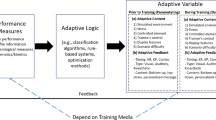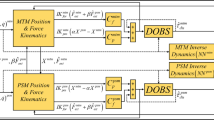Abstract
This paper extends previously proposed memory-based passivity approach (MBPA) to 6 degrees-of-freedom (DOF) haptic interactions. By introducing 6-DOF virtual proxy and virtual object, connected with haptic interaction point (HIP), we can extend MBPA to 6-DOF, including torque vs. orientation passivity. To find a passive relationship between positions vs. force graph, instead of position itself, we use position error between the center of mass of the virtual proxy and virtual object. For the angle vs. torque graph, we use angular displacement between the unit vector of the virtual proxy and virtual object instead of angle itself. After the extension, position/angular resolution became a problem, since it depends on configuration of the haptic device. Position resolution should be fixed, and real-time monitoring of every single position change is strongly required in previous MBPA. However, those are difficult requirements when the approach is extended to multi-DOF, especially 6-DOF including orientation. This paper revises the data saving procedure and force bounding mechanism to allow variable position resolution. Position value instead of simple incremental integer is saved together with matched force data into memory space, which allows to interpolate corresponding force value at the releasing trajectory even though it is not in the saved data list. This generalized framework of 6-DOF haptic rendering is evaluated according to simulation results.


















Similar content being viewed by others
References
Salisbury JK, Brock D, Massie T, Swarup N, Zilles C (1995) Haptic rendering: programming touch interaction with virtual objects. In: Proc. of ACM Symposium on Interactive 3D Graphics, pp 123–130
Colgate JE, Schenkel GG (1994) Passivity of a class of sampled-data systems: application to haptic interfaces. In: Proc. of American Control Conference
Colgate JE, Brown JM (1994) Factors affecting the z-width of a haptic display. In: Proceedings of IEEE Int. Conference on Robotics and Automation, pp 3205–3210
Hannaford B, Ryu J-H (2002) Time domain passivity control of haptic interfaces. IEEE Trans Robot Autom 18(1):1–10
Gosline AHC, Hayward V (2008) Eddy current brakes for haptic interfaces: design, identification, and control. IEEE/ASME Trans Mechatron 13(6):669–677
Srikanth MB, Vasudevan H, Muniyandi M (2008) DC motor damping: a strategy to increase passive stiffness of haptic device. In: Ferre M (ed) Haptics: Perception, Devices and Scenarios, EuroHaptics, Lecture Notes in Computer Science, vol 5024. Springer, Berlin, Heidelberg, pp 53–62
Do TH, Ryu JH (2011) Memory based passivation method for stable haptic interaction. In: IEEE World Haptics Conference, pp 409–414
Ryu JH, Yoon M-Y (2013) Memory-based passivation approach for stable haptic interaction. IEEE/ASME Trans Mechatron, pp 1–12
Colgate JE, Stanley MC, Brown JM (2005) Issues in the haptic display of tool use, in WHC’05. In: Proceedings of the First Joint Eurohaptics Conference and Symposium on Haptic interfaces for virtual environment and teleoperator systems), 21(5):952–964
Ellis RE, Sarkar N, Jenkins MA (1996) Numerical methods for the haptic presentation of contact: theory, simulations, and experiments. Proc ASME Dyn Syst Control Div 58:413–420
Gillespie B, Cutkosky M (1996) Stable user-specific haptic rendering of the virtual wall. Proc ASME Conf 58:397–406
Basdogan C, Laycock SD, Day AM, Patoglu V, Gillespie RB (2007) 3-Dof haptic rendering. In: Lin MC, Otaduy M (eds). Haptic Rendering. A.K. Peters, USA, pp 311–333
Paul RP, Zhang H (1986) Computationally efficient kinematics for manipulators with spherical wrists. Int J Robot Res 5(2):3244
Corke P, Armstrong-Helouvry B (1994) A search for consensus among model parameters reported for the PUMA 560 robot. In: Proc. IEEE Int. Conf. Robotics and Automation, (San Diego), pp 1608–1613
Corke P, Armstrong-Helouvry B (1995) A meta-study of PUMA 560 dynamics: a critical appraisal of literature data. Robotica 13(3):253–258
Willems JC (1972) Dissipative dynamical systems, part I: general theory. Arch Rat Mech Anal 45:321–351
Yasrebi N, Constantinescu D (2013) Passive multirate wave communications for haptic interaction in slow virtual environments. IEEE/ASME Trans Mechatron 18(1):328–336
van der Schaft AJ (2000) L2-gain and passivity techniques in nonlinear control. In: Communications and Control Engineering, 2nd edn. Springer, London
Armstrong B, Khatib O, Burdick J (1986) The explicit dynamic model and inertial parameters of the Puma 560 arm. In: Proc. IEEE Int. Conf. Robotics and Automation 1, pp 510–518
Preusche C, Hirzinger G, Ryu JH, Hannaford B (2003) Time domain passivity control for 6 degrees of freedom haptic display. In: IEEE/RSJ International conference on Intelligent Robots and Systems, vol 3. Las Vegas, pp 2944–2949
Acknowledgments
This research was partially supported by the National Research Foundation of Korea (NRF) grant funded by the Korea government (MSIP) (No. NRF-2013R1A2A1A03069658), and also this research was partially supported by the project “Development of core technologies for underwater construction robots including a light work class ROV,” funded by Ministry of Oceans and Fisheries, South Korea.
Author information
Authors and Affiliations
Corresponding author
Rights and permissions
About this article
Cite this article
Jafari, A., Ryu, JH. 6-DOF extension of memory-based passivation approach for stable haptic interaction. Intel Serv Robotics 8, 23–34 (2015). https://doi.org/10.1007/s11370-014-0161-y
Received:
Accepted:
Published:
Issue Date:
DOI: https://doi.org/10.1007/s11370-014-0161-y




